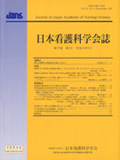Japanese
English
- 販売していません
- Abstract 文献概要
- 参考文献 Reference
- サイト内被引用 Cited by
要旨
本研究の目的は,緩和ケア病棟と一般病棟の看護師が抱く「よい最期」を記述すること,両病棟間の看護師が捉えるよい最期に違いがあるかどうかを検討することである.研究デザインは,質的帰納的研究デザインとした.研究協力者は,緩和ケア病棟に勤務する看護師10名,一般病棟に勤務する看護師12名である.インタビュー法と参加観察法を用いてデータ収集を行った.《家族に囲まれて亡くなっていく》《症状のコントロールができており苦しみがない》《残された時間を充実して過ごす》《静かな最期》《死を受け止める》という5カテゴリーが見出された.緩和ケア病棟と一般病棟の看護師が捉えるよい最期の像の特徴を比較すると,何を理想としているのかに大きな違いはみられなかったが,自分の捉えるよい最期が実現されていると考えているか,よい最期の実現に自分自身が関われていると考えているか,について違いがみられた.
Abstract
The purpose of this study was to clarify and explore the differences found between what nurses working in terminal care in palliative care wards and general wards, regarded as characteristics of a “good death”. This study was designed as a qualitative, inductive study. The study participants were 10 nurses working in palliative care wards and 12 nurses working in general wards. Data collection involved interviews and participatory observation.
The characteristics of what nurses regard as a good death were divided into 5 categories: “dying surrounded by family,” “control of symptoms was and no pain,” “time remaining was spent meaningful,” “peaceful ending,” “acceptance of dying.” When the characteristics of what was considered a “good death” are compared between nurses in palliative care and general care wards, no great difference was found in the ideal, but differences were found in whether nurses believe that their ideal of last moments were being realized, and whether nurses believed that they were contributing to and supporting the process for a good death.
Copyright © 2007, Japan Academy of Nursing Science. All rights reserved.


